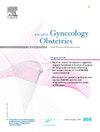Exploring the influence of perineal biometrics and stiffness measured by elastography during pregnancy on perineal tears : A pilot study
IF 1.7
4区 医学
Q3 OBSTETRICS & GYNECOLOGY
Journal of gynecology obstetrics and human reproduction
Pub Date : 2025-01-11
DOI:10.1016/j.jogoh.2025.102904
引用次数: 0
Abstract
Objectives
This study aimed to describe the biometrics and elasticity of the perineal body and the anal sphincter in the ninth month of pregnancy and explore their association with the risk of perineal tears during childbirth.
Methods
In this prospective observational study, pregnant women at 36–40 weeks of gestation were included. Using transperineal 2D-mode ultrasound and shear wave elastography (SWE), we measured the biometrics and stiffness of the perineal body (PB), external anal sphincter (EAS), internal anal sphincter (IAS), and anal mucosa (AM) at rest and during Valsalva maneuvers.
Results
Of the 16 women, five (31.2 %) were nulliparous and 10 (62.5 %) underwent a perineal tear. All were first degree perineal tears. Women with perineal tear had statistically a higher perineal body area at rest (0.9 ± 0.1 cm² versus 0.7 ± 0.1 cm², p = 0.03), a thicker EAS at 9 o'clock at rest (0.6 ± 0.2 cm vs 0.4 ± 0.1 cm, p = 0.03), a smaller anteroposterior diameter (1.7 ± 0.2 cm vs 2 ± 0.2 cm, p = 0.047), a smaller lateral diameter (1.4 ± 0.2 cm vs 1.6 ± 0.1 cm, p = 0.05) and a thinner IAS in average at rest (0.2 ± 0.0 cm vs 0.3 ± 0.0 cm, p = 0.007) and at 12 o'clock at rest (0.2 ± 0.1 cm vs 0.3 ± 0.0 cm, p = 0.002). The PB, EAS, IAS and AM elastic modulus in the ninth month of pregnancy tended to be higher in women with a perineal tear.
Conclusion
Assessing perineal and anal sphincter biometrics and stiffness via ultrasound and SWE is feasible and may indicate a risk of perineal tears.
Trial registration
The study was registered on (NCT05556304).
探索妊娠期间会阴生物特征和弹性测量刚度对会阴撕裂的影响:一项初步研究。
目的:本研究旨在描述妊娠第9个月会阴体和肛门括约肌的生物特征和弹性,并探讨它们与分娩时会阴撕裂风险的关系。方法:在这项前瞻性观察研究中,纳入了妊娠36-40周的孕妇。利用经会阴2d模式超声和剪切波弹性成像(SWE),我们测量了静息和Valsalva动作时会阴体(PB)、外肛门括约肌(EAS)、内肛门括约肌(IAS)和肛门粘膜(AM)的生物特征和刚度。结果:16例患者中,5例(31.2%)未生育,10例(62.5%)发生会阴撕裂。均为会阴一级撕裂。女性会阴撕裂了统计学上更高的会阴体区域静止(0.9±0.1厘米²和0.7±0.1厘米²,p = 0.03),一个厚9点钟EAS静止(0.6±0.2厘米和0.4±0.1厘米,p = 0.03),一个较小的前后的直径(1.7±0.2厘米和2±0.2厘米,p = 0.047),一个较小的横向直径(1.4±0.2厘米和1.6±0.1厘米,p = 0.05)和一个薄IAS平均静止(0.2±0.0厘米和0.3±0.0厘米,p = 0.007)和12点钟休息(0.2±0.1厘米和0.3±0.0厘米,p = 0.002)。会阴撕裂患者妊娠第9个月PB、EAS、IAS和AM弹性模量较高。结论:通过超声和SWE评估会阴和肛门括约肌生物特征和僵硬度是可行的,并可能提示会阴撕裂的风险。试验注册:研究注册号为(NCT05556304)。
本文章由计算机程序翻译,如有差异,请以英文原文为准。
求助全文
约1分钟内获得全文
求助全文
来源期刊

Journal of gynecology obstetrics and human reproduction
Medicine-Obstetrics and Gynecology
CiteScore
3.70
自引率
5.30%
发文量
210
审稿时长
31 days
期刊介绍:
Formerly known as Journal de Gynécologie Obstétrique et Biologie de la Reproduction, Journal of Gynecology Obstetrics and Human Reproduction is the official Academic publication of the French College of Obstetricians and Gynecologists (Collège National des Gynécologues et Obstétriciens Français / CNGOF).
J Gynecol Obstet Hum Reprod publishes monthly, in English, research papers and techniques in the fields of Gynecology, Obstetrics, Neonatology and Human Reproduction: (guest) editorials, original articles, reviews, updates, technical notes, case reports, letters to the editor and guidelines.
Original works include clinical or laboratory investigations and clinical or equipment reports. Reviews include narrative reviews, systematic reviews and meta-analyses.
 求助内容:
求助内容: 应助结果提醒方式:
应助结果提醒方式:


